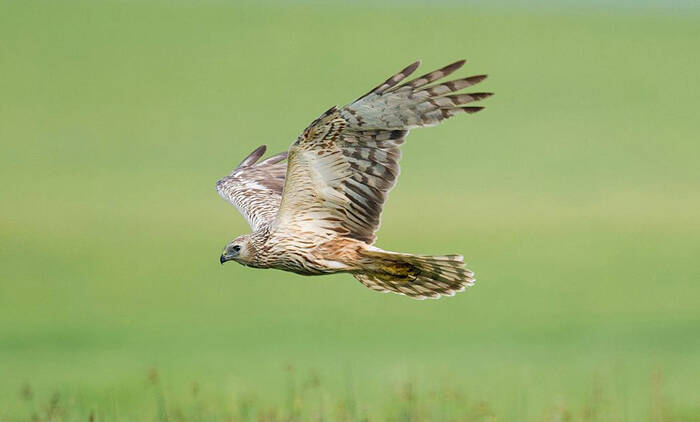Circus spilonotus
IUCN
LCBasic Information
Scientific classification
- name:Circus spilonotus
- Scientific Name:Circus spilonotus,Eastern Marsh Harrier,Marsh Harrier, White Tail
- Outline:Raptor
- Family:Falconiformes Accipitridae Harriers
Vital signs
- length:50-59cm
- Weight:490-780g
- lifetime:14-15years
Feature
Feather color changes with age
Distribution and Habitat
Distributed in eastern Asia, from the Baikal Lake area in Siberia to the east to the Pacific coast of the Russian Far East, and south through Mongolia, China, India, Southeast Asia to Oceania.
Native species distribution: Bangladesh, Brunei, Cambodia, mainland China, Coco Island, Hong Kong, Indonesia, Japan, North Korea, Laos, Malaysia, Mongolia, Myanmar, Papua New Guinea, Philippines, Singapore, Thailand, Vietnam.
Lost bird distribution: Iran, Northern Mariana Islands.
In China, it mainly breeds in Hulunbuir, Heilongjiang and Jilin provinces in northeastern Inner Mongolia; it winters in the middle and lower reaches of the Yangtze River, Yunnan, Guangdong, Hainan, Fujian, Hong Kong, Taiwan and other provinces.
It lives and moves in relatively humid and open places such as swamps, reed ponds, and the coasts of rivers and lakes.
Appearance
The male has white head, sides, nape and upper back with broad black-brown vertical stripes. The shoulders, lower back and waist are black-brown with dirty gray-white or light brown spots or feather ends. The upper tail coverts are white with irregular light brown spots. The tail feathers are silver-gray. The base and feather tips of the outer tail feathers are dirty white with light brown spots. The winglet feathers and primary coverts are silver-gray on the outside and brown with gray on the inside. The inner wing coverts are the same color as the back, black-brown with light feather edges. The outer 1 to 5 primary flight feathers are black-brown, with white bases on the inside and black-brown spots. The rest of the primary flight feathers, secondary flight feathers, and the large wing coverts and outer middle coverts are gray, with lighter tips and black sub-terminal spots. There are black bristles in front of the eyes, and the ear feathers are black-brown with yellow feather edges.
Details
Eastern Marsh Harrier is a medium-sized bird of prey with four subspecies.

Recently, studies based on molecular genetic evidence have supported the separation of white-headed harriers and white-bellied harriers, but there are still differences on their respective closely related species. It is now believed that the white-headed harrier is most closely related to the African marsh harrier (C. ranivorus), while the white-bellied harrier may be most closely related to the Madagascar harrier (C. macrosceles) or the Reunion harrier (C. maillardi), which are also in Africa. This shows that the past belief that the white-headed harrier and the white-bellied harrier were sister species based on morphology and distribution may have obscured the true evolutionary relationship between the two.
The white-bellied harrier is active during the day, alert and solitary, often alone or in pairs. It is often seen flying low over swamps and reeds, with its wings raised in a shallow "V" shape, gliding slowly and for a long time, occasionally flapping its wings a few times. When perching, it is mostly on the ground or on low mounds, and does not like to perch high like other birds of prey.
The white-bellied harrier mainly feeds on small birds, rodents, frogs, lizards, small snakes and large insects. Sometimes it also preys on various small and medium-sized water birds such as grebes, wild ducks, ducklings and pheasants, quails and hares on the ground. There are also reports of eating dead bodies and carrion. It usually forages during the day and is a relatively active hunter. It flies low over the ground most of the day to look for food. When it finds it, it suddenly descends to hunt, tearing it apart on the spot and swallowing it.
The white-bellied harrier is a summer migratory bird in Northeast China and a winter migratory bird or migratory bird south of the Yangtze River. It migrates to the breeding grounds in Northeast China from early to mid-April and leaves the breeding grounds from late October to early November.
The breeding season of the white-bellied harrier is from April to June. In the early breeding period, they often fly in pairs in the air for courtship performances, and start nesting from mid-April to the end of April. They usually nest in reeds on the ground, and occasionally in bushes. The nest is disc-shaped and made of reeds. Each nest lays 4 to 5 eggs, occasionally as many as 6 and as few as 3. The eggs are bluish-white, with a size of 48.5 to 53 mm × 37 to 39.5 mm, and an average of 50.8 mm × 38.2 mm. The female bird mainly incubates the eggs, and the incubation period is 33 to 38 days. The chicks are late-maturing, and the chicks are covered with white down feathers after hatching. They can only leave the nest after living in the nest for 35 to 40 days.
The overall population of the White-bellied Harrier has not been quantified, but it is rare in Russia and northern Japan (del Hoyo et al. 1992). The bird's population estimates are as follows: Taiwan, China, has about 50-1,000 wintering birds; South Korea has about 50-1,000 wintering birds; Japan has about 100-10,000 breeding pairs and about 50-1,000 wintering birds; Russia has about 10,000-100,000 breeding pairs and 1,000-10,000 migratory birds (Brazil 2009). The bird's population trend is stable.
Listed in the IUCN Red List: Least Concern (LC), assessed in 2012.
Listed in the "National Key Protected Wildlife List": National Second Class Protected Animal (effective December 10, 1988). (Note: Falconiformes, Accipitridae, other eagles).
Protect wildlife and eliminate game.
Maintaining ecological balance is everyone's responsibility!








